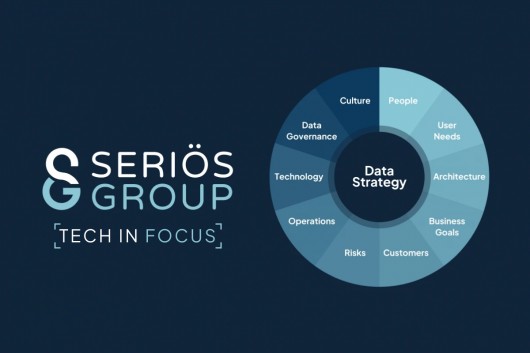Insights
Why Your Data Strategy Should Be Agile and Evolving

- Category
- Blog
- Date published
- 04.10.2025
- Written by
- Adam Brown, Head of Data Strategy and Architecture at Seriös Group
We all like the idea of a clear, structured plan, something that lays out exactly how to become a data-driven organisation. But when it comes to data strategy, being too rigid can slow progress and drive up costs. The most effective strategies aren't fixed blueprints. They're flexible frameworks that grow and shift alongside your business.
In short, your data strategy should be able to adapt.
The Cost of Rigidity
Data, by its very nature, is dynamic. Markets shift, customer preferences evolve and technologies rapidly advance. Consider a financial services firm that meticulously crafted a multi-year data strategy. When an unexpected merger occurred, their rigidly defined approach lacked the agility to quickly integrate new data assets, resulting in prolonged integration timelines, duplicated efforts and missed opportunities to use combined customer insights.
The urge to "get it right" from the outset often results in strategies that are overly complex, excessively theoretical and ultimately undelivered. Instead of driving change, they stay in PowerPoints, detached from the teams tasked with execution.
The Power of Agility
An agile data strategy thrives on uncertainty and embraces adaptation. When you discover a 'sweet spot', for example where user needs align directly with strategic objectives, that’s an opportunity. Imagine identifying a customer trend through real-time analytics, rapidly pivoting your product strategy and increasing revenue by double digits within months. These aren't accidental wins, they're strategic agility in action.
Principles for a Responsive Data Strategy
How do you build a data strategy structured enough for clarity yet adaptable enough to make the most of opportunities?
Lead with Vision, Adapt the Details: Begin with clearly defined business outcomes and high-level capabilities. Avoid dictating every technological solution upfront. Allow "the how" to be discovered collaboratively.
Phase-driven Delivery: Organise strategy execution into clear phases (Discover, Define, Plan, Execute, Adapt). Each phase validates assumptions, actively engages stakeholders and incorporates lessons learned before moving forward.
Embedded Feedback Loops: Continuously capture feedback on what's working, what's not and emerging opportunities from teams and end-users. This creates a culture of continuous improvement.
Prioritise Impact Over Perfection: Strive for quick, demonstrable value. Early wins boost confidence, drive momentum and encourage stakeholder buy-in, even if they weren't part of your original grand plan.
Maintain a Dynamic Portfolio: Keep an evolving list of potential projects and initiatives, clearly linked to their business cases and anticipated outcomes. This portfolio should be regularly reviewed, easily re-prioritised and transparent across teams. Being able to swiftly pivot your focus ensures your strategy remains aligned with changing business needs and opportunities.
The Role of Data Governance
Adaptive strategies still require accountability. Data governance acts as a strategic guide, not a barrier. Consider a Data Steering Committee: composed cross-functionally, it challenges and supports necessary pivots, ensuring alignment, resources and clear communication. This group will help to keep your data strategy flexible but purposeful, constantly aligning decisions to measurable business outcomes.
When to Add Structure
As your data maturity grows, moments arise requiring greater structure. This doesn't mean reverting to rigidity, it means formalising proven successes. Clearer standards, defined roles and scalable architectures evolve naturally from successful experimentation. For example, ad-hoc processes that delivered early wins transition into standardised frameworks, enabling faster replication and sustained success across teams.
Data Strategy Success
Too many data strategies get stuck or even fail, not from lack of ambition but lack of adaptability. The highest performing organisations succeed because their data strategies are visionary yet grounded, agile yet accountable.
Audit your data strategy regularly. Can it adapt and evolve? Let your data strategy grow with your business, continuously aligning, refining and able to make the most of real-world opportunities.
Your data strategy should give you answers, so you can make data-led decisions and turn insights into business impact.



